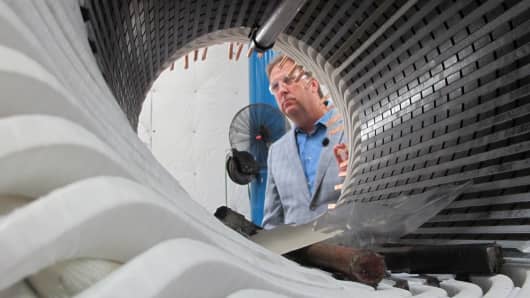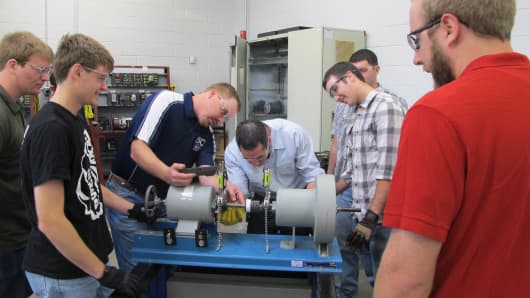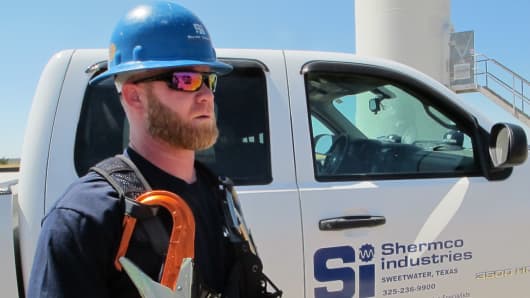Sweetwater, Texas, 225 due west of Dallas, made its mark in the late 1800s as a railroad hub. Today, it's known for the power of wind that blows in off the prairies.
Sweetwater is the county seat of Nolan County, home to 1,371 turbines, according to Sweetwater's Chamber of Commerce. It is also home to Texas State Technical College (TSTC), which has offered an associate's degree in wind energy and applied engineering since 2006.
"If my students get through the program and graduate with no background issues, I can pretty much guarantee they will get a job," said Heath Ince, chairman of the college's wind energy technology program and applied engineering department.
The Bureau of Labor Statistics expects the number of jobs for wind-techs, as they are known, to increase by 24 percent from 2012 to 2022, well above the average growth rate for all jobs of over 11 percent. Still, it's starting from a small base. In 2012, there were 3,200 wind tech jobs; by 2022, it is expected to jump to around 4,000.
Source: Guy Morton
Ron Widup, Shermco Industries CEO
"We have the jobs, but we can't find the people," said Ron Widup, CEO of Irving, Texas-based Shermco Industries, which provides maintenance and repair services to the wind industry, among others. "There's a tremendous demand for that classification of technician and engineer."
Behind this growing demand for wind technicians and engineers is the growing demand for wind power. From 2008 to 2012, the amount of electricity generated by wind increased by 154 percent. Wind is now the fifth largest source of electricity in the U.S. While wind only accounts for 4.4 percent of the total, it could generate 10 percent of all electricity in the U.S. by 2020, according to the Department of Energy.
"I think it's got a big future" said Harold Perrigo, a 33-year-old student in TSTC's wind program, when asked why he wants to be a wind technician. "It's a young industry and it is something that's going to grow exponentially over the next 10-15 years."
The history of wind power has not been without its doubters, or its stops and starts. In the past, its development and growth have relied heavily on federal and state tax incentives. As the incentives expired and were renewed, the industry's growth waxed and waned.
Still, the American Wind Energy Association said the cost of generating electricity from wind has been cut in half in the last five years, and the investment bank Lazard points out that producing electricity from wind is almost as cheap as traditional sources like coal and gas, even without the subsidies.
Lights! Camera! JOBS! But not where you might think
Shermco, which counts wind power as 20 percent to 25 percent of its business, has had to work closely with colleges like TSTC to assure it has the workers to repair wind turbines and service the industry's substations. Widup said his company is always looking to hire a couple of technicians a year, at competitive salaries.
"You are coming in as an entry-level job probably $40,000 to $45,000 a year and with overtime very quickly can get to $60,000 to $80,000," he said. "Then in a few years it's not uncommon to get to six figures pretty quickly in this field."
Source: Guy Morton
Students in Wind Energy program at Texas State Technical College in Sweetwater, TX.
Thirty-four-year-old Jeremy Brackenridge joined Shermco a few months ago. A veteran of the oil and gas industry, he is going through in-house training to become a wind technician. It is a job that pays him more than he was earning fixing gas turbines.
"I'm making about 10 percent more than I was," he said.
Brackenridge also expects to make a career at Shermco. He bounced around after high school working odd jobs, and in manufacturing and oil and gas before landing in wind. He hopes to become a project manager.
Source: Guy Morton
Jeremy Brackenridge, Shermco Industries wind turbine technician
For others like Perrigo, school is the path to getting into the industry. He relocated to Texas from Pennsylvania, where he worked in retail. He has a semester and a half to go before he graduates from TSTC with an associates degree in applied science degree in wind energy.
Ince said the industry is looking for people who can read schematics and have good electrical and mechanical skills. He said he meets with industry representatives once a year to make sure he is teaching his students what the industry tells him their future employees need to know.
Growing cyberthreat means more jobs in US
"We start off with them with just a basic introduction to wind energy," Ince said. "And then we elevate from there. We start talking about hydraulics, we teach them hydraulic schematics, we teach them some industrial automation."
The school also makes sure the students can handle a critical part of the job, working a couple of hundred feet off the ground. You can't have a fear of heights if your career takes you where the wind blows.
Mary ThompsonCNBC Reporter





No comments:
Post a Comment